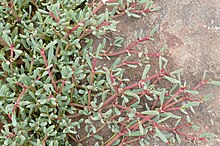| Sesuvium edmonstonei | |
|---|---|

| |
| Galapagos carpet weed (March 2005) | |
| Conservation status | |
 Least Concern (IUCN 2.3) | |
| Scientific classification | |
| Kingdom: | Plantae |
| Clade: | Tracheophytes |
| Clade: | Angiosperms |
| Clade: | Eudicots |
| Order: | Caryophyllales |
| Family: | Aizoaceae |
| Genus: | Sesuvium |
| Species: | S. edmonstonei |
| Binomial name | |
| Sesuvium edmonstonei Hook.f. | |
Sesuvium edmonstonei, commonly known as Galapagos carpet weed, is a species of plant in the family Aizoaceae. It is endemic to the Galápagos Islands (Ecuador).
Description

Sesuvium edmonstonei is a low-growing perennial plant. The stems, which are fleshy and covered with scales, are sometimes woody at the base. The succulent leaves are oblanceolate and grow in opposite pairs; they are simple, entire and up to 3 cm (1.2 in) long. The flowers grow in the leaf axils, each having a five-lobed white calyx, no petals, and many stamens. The fruits that follow are ovoid capsules, with lids, containing black seeds with wrinkled cuticles. The plants develop orange and red hues in the cool season.
Distribution and habitat
This succulent plant is endemic to the Galapagos Islands. It is found on Darwin Island, Española Island, Fernandina Island, Floreana Island, Genovesa Island, Isabela Island, Rábida Island, San Cristóbal Island, Santa Cruz Island, Santiago Island and Wolf Island. It spreads in sheets across both rocky and sandy ground.
References
- ^ Tye, A.; Kling, M. (2014). "Sesuvium edmondstonii". IUCN Red List of Threatened Species. 2014: e.T39070A61481431. doi:10.2305/IUCN.UK.2014-3.RLTS.T39070A61481431.en. Retrieved 16 November 2021.
- Sesuvium edmonstonei Archived 2012-06-12 at the Wayback Machine ZipCodeZoo.com Archived 2008-01-05 at the Wayback Machine Downloaded on 9 August 2009
- ^ McMullen, Conley K. (2018). Flowering Plants of the Galápagos. Cornell University Press. p. 245. ISBN 978-1-5017-2876-1.
External links
![]() Media related to Sesuvium edmonstonei at Wikimedia Commons
Media related to Sesuvium edmonstonei at Wikimedia Commons
| Taxon identifiers | |
|---|---|
| Sesuvium edmonstonei | |
This Aizoaceae article is a stub. You can help Misplaced Pages by expanding it. |